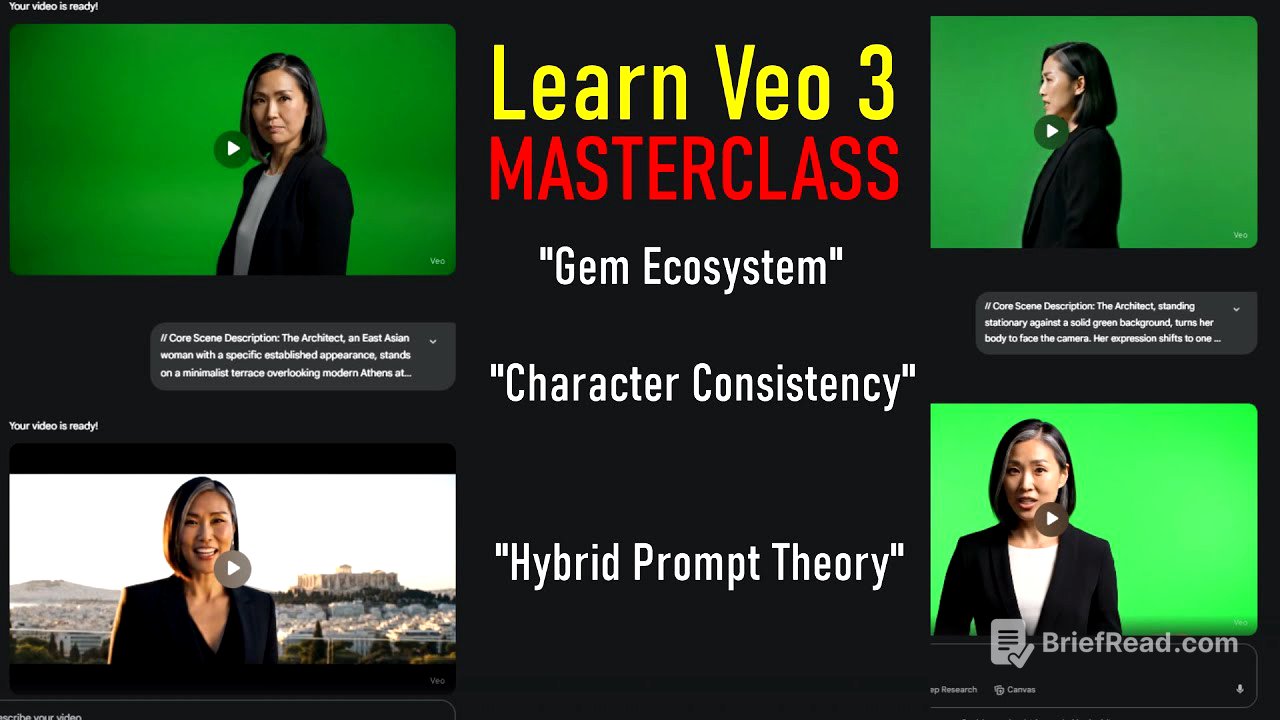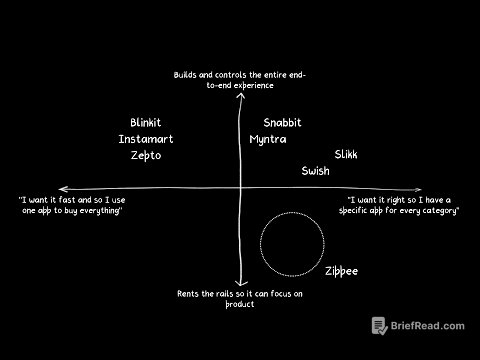TLDR;
This video explains how to optimize prompts in V3 using "gems" (specialized AI assistants) to improve character consistency and overall output quality. It introduces the concept of a "hybrid prompt," combining code-block and descriptive paragraph formats for detailed and effective instructions. The video emphasizes spending time refining prompts in Gemini before using V3 to maximize efficiency and minimize wasted credits.
- Optimizing V3 prompts using AI "gems"
- Maintaining character consistency across scenes
- Introducing the "hybrid prompt" theory
- Maximizing efficiency and minimizing wasted credits
Introduction [0:00]
The video serves as a direct continuation of the previous lesson, focusing on optimizing AI prompts within V3 to avoid wasting credits due to poorly constructed prompts. The lesson aims to revolutionize prompts by integrating two AI "gems" to work together on a project. The video will cover the ecosystem between gems, tips for maintaining character consistency, and the introduction of a hybrid prompt format.
Recap of Gem Setup [0:32]
The video recaps the setup of two AI "gems": the Dream Weaver and the Scene Weaver. The Dream Weaver provides an overview of its capabilities, emphasizing its role in coordinating with the Scene Weaver. The Scene Weaver offers a more technical response, reflecting its specialization as an AI technical director. The video references a previous episode where these gems were created, recommending viewers to watch it for context.
Project Goal and Initial Ideas [3:18]
The goal is to create a channel trailer using AI-generated clips, demonstrating the developed system. The video details the initial conversation with the Dream Weaver, tasking it with generating ideas for the trailer while considering V3's limitations of 8-second clips. The Dream Weaver provides three initial ideas, and the presenter selects the "uncanny picnic" concept, which involves contrasting a detailed narrator with an uncanny valley background.
Exploring V3's Capabilities and the Handoff [6:03]
The presenter explores V3's ability to intentionally create poor-quality imagery while maintaining character realism. The Dream Weaver expands on the chosen idea and provides a "handoff" command, which is a paragraph that can be copied and pasted into the Scene Weaver to create the technical AI prompt. The presenter briefly mentions the hybrid prompt theory, questioning whether the handoff should be in codelock or description form.
Incorporating Film Theory and Narration [8:23]
The presenter asks the Dream Weaver for its opinion on whether there should be narration in the video, considering its knowledge of film theory and viewer attention. The AI suggests different paths, including the power of silence and immediate narration. The presenter explores the idea of a brief silence followed by the narrator speaking. The AI generates a line, "Are you seeing what I'm seeing?" which the presenter deems not great. The Dream Weaver then prepares the final package for the Scene Weaver.
Character Consistency and Design [10:31]
The presenter emphasizes the importance of character consistency and decides to define a consistent narrator for all scenes. The Dream Weaver is tasked with creating a character profile, suggesting a woman in her early 40s with specific physical and behavioral traits. The presenter approves the character and the Dream Weaver provides a detailed handoff for the Scene Weaver, including separate paragraphs for scene description and character profile.
Addressing Rendering Issues and Composite Clips [13:23]
The initial clip rendering faced issues with detailing, leading to the idea of creating two separate clips: one for the background and one for the narrator on a green screen. This composite approach allows for better control and quality in both clips. The presenter mentions that V3 can be prompted to produce a green screen effect.
Refining Narration and Brainstorming Backgrounds [15:23]
The presenter refines the narration style, avoiding internal monologues to showcase V3's lip-sync capabilities. The AI is prompted to brainstorm background ideas, and the presenter selects the "impossible fountain" concept. The AI generates a narration line, "V3 is expensive. The daily limits come fast and stop wasting your credits," which the presenter approves.
Accent Selection and Character Profile Integration [18:17]
The presenter asks the AI to suggest an appropriate accent for the character, considering her visual appearance. The AI provides three options: a transatlantic accent, standard British, and clear North American. The presenter chooses the North American accent. All character details are then integrated into the profile to ensure consistency across scenes.
Prioritizing Prompt Refinement in Gemini [19:41]
The presenter emphasizes the importance of spending time refining prompts in Gemini to make descriptions as perfect as possible before using V3. The AI can be used to explore concepts, assess the likelihood of a prompt being understood, and identify any missing elements. The presenter tells the gem that he only has one credit left for the day, so he needs to nail it.
Scene Weaver and Code Block Style Prompt [25:26]
The presenter transitions to Scene Weaver to produce a scene, aiming to use the prompt given on the first try. The AI generates a code block style prompt output, which is a long, singular line that can be copied and pasted into V3. The AI requests audio details, prompting the presenter to return to Dreamweaver and coordinate the audio aspects.
Character Profile and Final Output Generation [27:15]
The presenter revises the prompt to include the character profile, specifying her appearance, accent, and other details. The AI is instructed to generate the final output, treating it as a real clip rather than a test. The AI offers the output in structured code block form, descriptive paragraph form, or both.
Testing Code Block and Descriptive Paragraph Prompts [29:11]
The presenter tests the code block and descriptive paragraph prompts in V3, producing the same scene twice to compare the results. The code block prompt results in detailed architect but odd movement, while the descriptive paragraph prompt results in natural movement but lacks audio and crisp detail. The background is poor in both versions.
Devising the Hybrid Prompt [31:41]
Based on the test results, the presenter and the AI devise a hybrid prompt, combining the code block and descriptive paragraph styles. The AI analyzes the strengths and weaknesses of each style, determining that the code block provides superior detail due to its checklist-like structure, while the descriptive paragraph offers natural flow. The presenter asks if it is even possible to have a hybrid of two styles prompts.
Implementing the Hybrid Prompt and Addressing Lighting [32:43]
The AI provides a list of how best to use the hybrid prompt. The goal is to create an entire vision and goal, let Gemini understand what it is, and then feed back the specific language that V3 would need to. The presenter creates a structured code block and descriptive paragraph, but it's not easy to enter that. The presenter asks how would be the best way to copy and paste that as a single block of text into the v3 prompt box.
Hybrid Prompt Attempt and Character Consistency [35:02]
The presenter attempts the hybrid prompt in V3, but the green screen effect is not correct. The presenter also notices that the character is different from the previous clips. The presenter asks if there was something in the prompt that specified that. The AI explains that the model makes its own decisions based on the descriptions provided, highlighting the importance of being specific in character consistency details.
Adding Ethnicity and Prioritizing Character Consistency [36:00]
Ethnicity is added to the character profile to improve consistency. The presenter emphasizes the importance of character consistency and seeks to lock in the process for the next prompt. The AI understands the importance of the last credit and aims to ensure that the next prompt is consistent with the last one.
Final Scene and Hybrid Prompt Drafting [38:36]
The AI drafts the hybrid prompt for the final scene, prioritizing character consistency. The presenter is encouraged to review the prompt. The AI specifies that the absolute top priority here will be ensuring the architect's established profile is explicitly and meticulously defined to maintain perfect consistency within the character from clip A into clip C.
Audio Design and Consistent Character Phrase [39:37]
The presenter notices the inclusion of "ambient city sounds" in the prompt, which he notes can be problematic. The presenter also observes that the phrase "consistent character" is missing from the prompt and asks if it is necessary. The AI explains that the detailed multi-point description is the most effective way to ensure consistency, but the phrase can be a helpful reinforcement.
Final Prompt and Character Consistency Test [42:04]
The presenter reviews the final prompt, which includes camera style, art, visual style, environment, sound design, and narration. The presenter tests the prompt in V3, and the resulting clip shows a character that is not exactly the same as the previous ones. The presenter reaches his video generation limit for the day.
Hybrid Prompt Theory and Conclusion [43:36]
The presenter concludes by having the Scene Weaver explain the hybrid prompt theory. The presenter feels like this is a revolutionary style of prompting and it should be adopted by more people. The presenter reiterates the importance of using a detailed, well-structured prompt and assures viewers that the system is built to handle highly descriptive prompts. The presenter offers consultations for those who want to learn the entire system.









